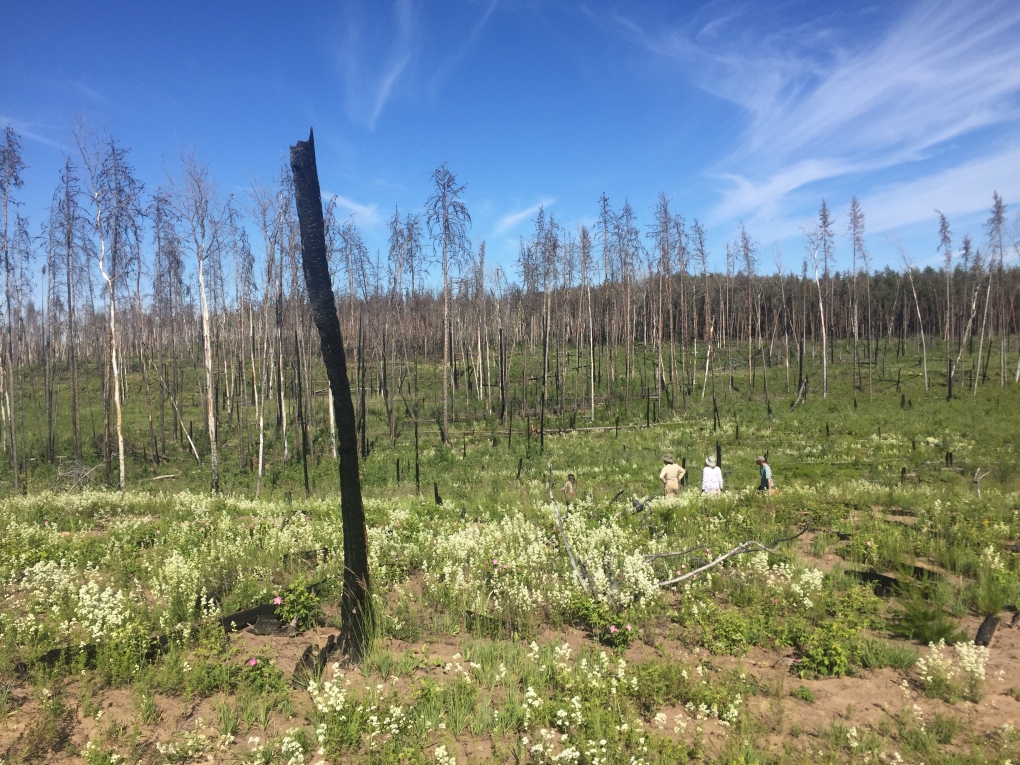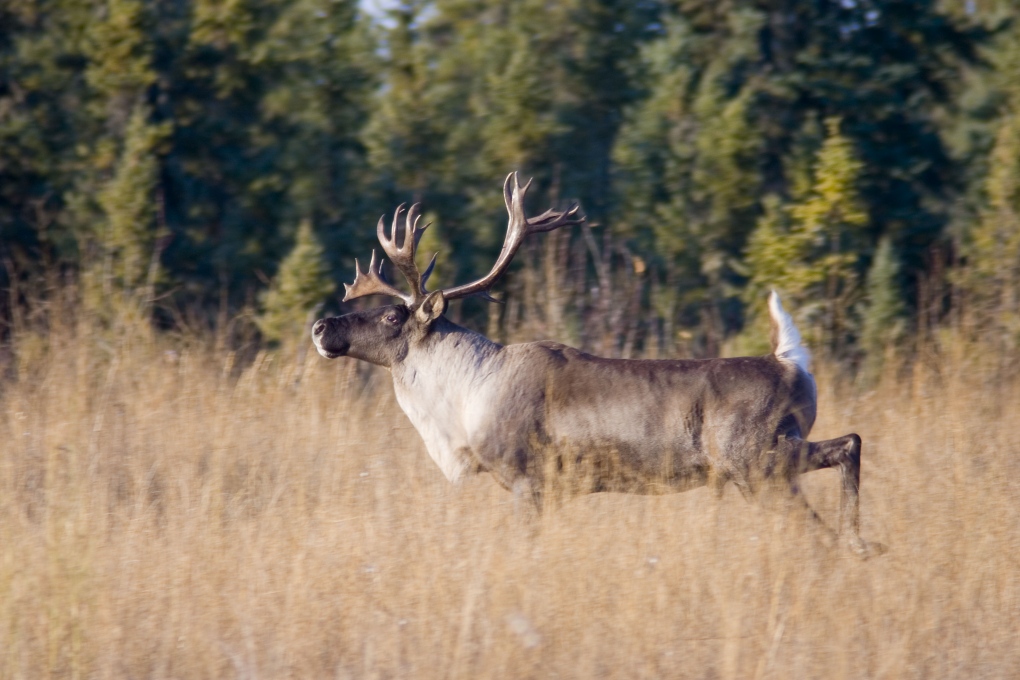Size of Vancouver Island burned in 2023 Alberta wildfires: ABMI report
A group of researchers who studied the historic 2023 Alberta wildfires calls them “remarkable” at least in recent history.
The Alberta Biodiversity Monitoring Institute (ABMI) found 6.6 per cent of Alberta’s forest burned, disturbing as much forest as the 11 previous years combined.
“We think around 32,000 square kilometers of forest burned so that's about the size of Vancouver Island,” said Brandon Allen, who is a senior terrestrial ecologist with the ABMI.
Its count is higher than the province’s estimate of 2.2 million hectares of land burned because it includes national parks, an area outside the Forest Protection Area (FPA).
“The boreal was quite heavily hit. Places like Wood Buffalo National Park, we estimate about 20 per cent of the area was burned,” Allen told CTV News Edmonton earlier this month.
An ABMI report states nearly 750,000 hectares was scorched in Wood Buffalo National Park, an area larger than Banff National Park. It called fires a “natural occurrence” in Alberta however it said 2023 was an “exceptional year”.
It called fires a “natural occurrence” in Alberta however it said 2023 was an “exceptional year”.
“Your upland forests, your lowland forests, your marshes, your bogs, they all seemed to be burdened relatively equal amounts. And same with how old the forests were as well,” said Allen.
“There wasn’t any sort of bias towards one habitat type being burned or another.”
Indiscriminate burning of habitat ‘not normal’ experts say
A forest fire research scientist with Natural Resources Canada said young forests are much less likely to burn than old forests.
“They just have less fuel. So less vegetation, less thick, organic soil layers that have built up over time. Less ladder fuels like shrubs and understory branches,” Ellen Whitman told CTV News Edmonton.
“The thing that we can infer from that is that there was really, really extreme weather that enabled that to happen.”
Whitman said 2023 was Alberta’s hottest and driest fire season since the 1940s.
And over the past three decades, scientists have noticed an increase in forests repeatedly burning in short intervals.
“When we burn young forests, what happens is, essentially, we're burning them before they have mature seed sources and seed availability,” Whitman said.
 A forested area that has been burned repeatedly. (Provided by Ellen Whitman)In severe cases, she said an impacted forest could fail to recover.
A forested area that has been burned repeatedly. (Provided by Ellen Whitman)In severe cases, she said an impacted forest could fail to recover.
“I am much more concerned about short-interval reburns ecologically than I am about mature forest burning. It takes a long time for those mature forests to come back but they have the seeds available to do that.”
Extreme fire seasons can ‘dramatically affect forest biodiversity’: ABMI
The 2023 wildfires both increased and decreased animal habitat according to the ABMI report.
Boreal Chickadees lost just over 4 per cent of its habitat while Black-backed Woodpeckers saw a nearly 13 per cent increase.
“Species like woodpecker are going to thrive. They have all of these new nesting cavities that they can take advantage of. Some old forest birds are not going to do as well,” said Allen.
Woodland Caribou — which is considered a species at risk — lost just over 5 per cent of its habitat.
Two northern caribou ranges saw close to 13 and 14 per cent losses.
“Time will tell how these changes in the fire regime will impact caribou. But we need to make sure that we're watching and that we're ready to act quickly,” said Melanie Dickie, a senior caribou ecologist with the ABMI. A caribou photographed by Chris Kolaczan.The report notes a possible greater effect on caribou is an influx of moose and deer in areas of regrowth.
A caribou photographed by Chris Kolaczan.The report notes a possible greater effect on caribou is an influx of moose and deer in areas of regrowth.
“When there are more moose and deer on the landscape, there are often also more predators like wolves, which predate on caribou at unsustainable rates,” said Dickie.
She said the impact of increasingly severe fire seasons should be included in the province’s caribou protection plans.
Looking ahead
The ABMI report states the “critical question” about the 2023 wildfire season is whether it represents a rare event or something we will see more of in the future.
“If this is a one time event, this is something that these forests are adapted to. This is a very normal thing for them,” said Allen.
“If this happens every year going forward, it'll definitely impact the ecosystem more.”
Whitman said scientists have already associated warming and drying trends in Alberta to an increase in large fires and land burned.
“2023 fits with that trend and the key thing to remember is that when we have really high temperatures, the moisture holding capacity of that air is much higher,” she said.
“So even if you get more rain, hot temperatures mean that more moisture can be pulled out of your fuels so you actually need a lot of precipitation and moisture on the landscape to compensate.”
CTVNews.ca Top Stories

Iran President Ebrahim Raisi still missing after helicopter accident in mountains
A helicopter carrying Iranian President Ebrahim Raisi, the country's foreign minister and other officials apparently crashed in the mountainous northwest reaches of Iran on Sunday, sparking a massive rescue operation in a fog-shrouded forest as the public was urged to pray.
What do we know so far about the mysterious crash of the helicopter carrying Iran's president?
The apparent crash of a helicopter carrying Iran's president and foreign minister on Sunday sent shock waves around the region.
'A horrible way to start the summer': 3 killed in serious boat crash on lake north of Kingston, Ont.
Three people were killed and five others were injured Saturday night following a boat crash on the Buck Bay area of Bobs Lake, north of Kingston, Ont., the Ontario Provincial Police (OPP) said.
Walmart, Costco refusing to sign grocery code of conduct 'untenable': industry minister
Industry Minister Francois-Philippe Champagne says it's 'untenable' for 'smaller players' like Walmart and Costco to delay signing on to the government- and industry-led grocery code of conduct, now that industry giant Loblaw has agreed to do so.
Ottawa driver who appeared to be racing another vehicle on Highway 416 facing charges
The Ontario Provincial Police (OPP) says an Ottawa driver is facing charges after being caught going 187 km/h on Highway 416.
Ex-partner charged with first-degree murder after 55-year-old woman killed in Montreal
Less than 24 hours after Montreal's 12th homicide investigation began, Montreal police confirmed that a 55-year-old woman's death in St. Michel is the island's 13th homicide. The woman's ex-spouse has been charged with first-degree murder.
VIDEO Born without front legs, this dog has been inspiring the world for 3 years: Dresden farm owner
A sanctuary dedicated to animals with disabilities is celebrating the third birthday of one of its most popular residents.
Canadian immigration asks medical worker fleeing Gaza if he treated Hamas fighters
Lawyers are questioning Canada’s approach to screening visa applications for people in Gaza with extended family in Canada after one applicant, a medical worker, was asked whether he had treated members of Hamas.
Diddy admits beating ex-girlfriend Cassie, says he's sorry, calls his actions 'inexcusable'
Sean 'Diddy' Combs admitted Sunday that he beat his ex-girlfriend in a hotel hallway in 2016 after CNN released video of the attack, saying in a video apology he was 'truly sorry' and his actions were 'inexcusable.'
































